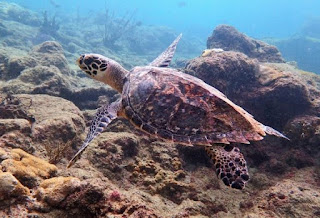 |
| Hawksbill sea turtle at Castara, Tobago. Photo by Mike Rutherford. |
Background
There are five sea turtle species recorded for Trinidad and Tobago: Leatherback (
Dermochelys coriacea), Hawksbill (
Eretmochelys imbricata), Green (
Chelonia mydas), Loggerhead (
Caretta caretta) and Olive Ridley (
Lepidochelys olivacea) [Murphy et al. 2018]. All five are designated Environmentally Sensitive Species (ESS) in T&T. Sea turtles face various threats. Some of these include climate change, loss of habitat, pollution (including from artificial light) and poaching/exploitation (Hailey and Cazabon-Mannette 2011). Poaching of sea turtles occurs in Trinidad and Tobago despite the year long legal protection of these ESS.
Aim
In 2018 as part of a
Conservation Leadership in the Caribbean programme, I embarked on a venture to acquire current information on the status of poaching of sea turtles in Tobago, Trinidad and Tobago, specifically to understand the culture and perception as to why it persists for hopes of improving future conservation management plans for the species to be used by relevant stakeholders.
Method
I spoke with some of the main stakeholders involved in turtle conservation on the island (n=8), including government officials, and non-governmental officials, which included those from turtle patrol groups, and community conservation personnel (where turtle patrol groups were absent from known nesting villages). The objectives were to gain a better understanding of the demand for consuming sea turtles and their eggs.
Results
Poaching is regarded as the main threat to sea turtles on the island, particularly in the north, whereas habitat loss/alteration is regarded as a major threat to sea turtles in the south of the island. This may be unsurprising as the south of the island is more developed and development is continuing to meet the needs of tourism, whereas the north of the island may be considered more rural.
Speaking about the particular species of sea turtles, the hawksbill is perhaps the most exploited of the sea turtles on Tobago. Reason being that it is a preferential choice by the locals to consume the meat of hard shell species compared to the leatherback. The hawksbill is also a more frequent nesting species in the north of Tobago than the leatherback, whereas the other hard shell species such as the green (nesting females) is less common. The hawksbill is currently regarded as
Critically Endangered.
Contributing factors and Challenges:
-turtle meat is viewed as a cultural status (turtle meat is more highly regarded than perhaps chicken or fish);
-food source (one local referred to turtle meat as "sea goat" and says people like how it tastes and it would be difficult to stop eating it);
-lack of financial alternatives (which is an issue among many rural communities);
-lack of financial support for turtle conservation (there are, but perhaps more is needed);
-Lack of enforcement and support from local government (most game wardens only work from 8 am to 5 pm, but sea turtles nest predominantly at night);
-limited legislation (lack of prohibited turtle nesting beaches on Tobago, unlike on Trinidad);
-remoteness of nesting beaches on Tobago (access to monitor and patrol all nesting beaches is already made difficult by lack of resources and finances, but the inability to easily access some beaches is also a problem);
-increased craftiness of poachers (for example, knowing how to avoid persons on patrols and using the latest technology);
-some people that are on beaches monitoring turtles may also be poachers or colleagues of poachers (but with limited persons willing to help out, how does one vet such a situation?);
-lack of awareness/knowledge gap (one official claimed that sea turtles should be eaten to keep their populations in check - although did acknowledge that more data are needed to validate this).
Management measures needed:
-more educational awareness programmes to highlight the importance of sea turtles (and how they help people and boost the economy);
-greater support from the local government;
-patrols on beaches where turtles are known to nest but currently has no monitoring in place (perhaps implement a community plan for those from the community to monitor these beaches?);
-greater financial support, which, is needed to help with all management measures (there can be incentives for conserving these species, which in the long term can not only be beneficial to the turtles, but for ecotourism and the economy of the country);
-designating prohibited areas for high density turtle nesting areas (although perhaps it may seem this may clash with tourism, on the contrary, considering how much money comes in just from people paying to watch sea turtles on Trinidad, this is something that can be followed up on Tobago).
Conclusion
More work is needed. It will require a collaborative effort but most importantly, from people at the local communities. They stand to benefit from having these sea turtles around as do all. This has been reported by Cazabon-Mannette and colleagues (2017) who found that there are significant non-use and non-consumptive values of sea turtles in Tobago, and this highlights the importance of sea turtle conservation efforts in Tobago. If the the turtles are gone, not only will the marine ecosystem and all the other species (including fish) diminish, but also the local economy.
 |
Leatherback laying eggs. Photo by Renoir Auguste.
|
References
Cazabon-Mannette, M., Schumann, P.W., Hailey, A., and Horrocks, J. 2017. Estimates of the non-market value of sea turtles in Tobago using stated preference techniques. Journal of environmental management 192: 281-291.
Hailey, A., and Cazabon-Mannette, M. 2011. Conservation of herpetofauna in the Republic of Trinidad and Tobago. Pp 183-217 in Hailey, A., Wilson, B.S., and Horrocks, J.A. (Eds.), Conservation of Caribbean Island Herpetofaunas, Volume 1, Conservation Biology and the Wider Caribbean. Leiden: Brill.
Murphy, J.C., Downie, J.R., Smith, J.M., Livingstone, S.R., Mohammed, R.S., Auguste, R.J., Lehtinen, R.M., Eyre, M., Sewlal, J.N., Noriega, N., Casper, G.S., Anton, T., Thomas, R.A., Rutherford, M.G., Braswell, A.L., and Jowers, M.J. 2018. A field guide to the amphibians and reptiles of Trinidad and Tobago. Trinidad and Tobago Field Naturalists’ Club. 336 pp










